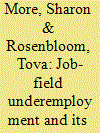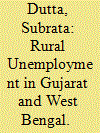| Srl | Item |
| 1 |
ID:
183998


|
|
|
|
|
| Summary/Abstract |
This article explored the impact of the match between Israeli academics’ educational field and occupational field (job-field underemployment) on their decision-making regarding acquiring further academic degree. It found a greater willingness for further higher education acquirement among those whose educational and occupational fields are matched. The article’s unique contribution lies in showing job-field underemployment to be a very significant factor in the individual’s career decision-making process. As such, it underscore the importance of informed educational decisions for generating a resilient career path to cope with potential future career setbacks.
|
|
|
|
|
|
|
|
|
|
|
|
|
|
|
|
| 2 |
ID:
163584


|
|
|
|
|
| Summary/Abstract |
Based on NSSO data sets, this study covers the period from 1993 to 2010 and focuses on a comparison of rural unemployment in Gujarat and West Bengal, chosen because of their contrasting characteristics. In the past few decades, Gujarat has emphasised growth through modern industrial production, while under a different ideological regime, West Bengal aimed to achieve agricultural growth, land reform and more egalitarian patterns of agricultural incomes. Recent evidence suggests that meanwhile Gujarat’s agriculture has registered high growth in output during 2000–08, while West Bengal has failed to kick off industrialisation, despite making some pressing efforts. The article clearly identifies the limited scope for agriculture to provide full employment for all young rural people in India. However, given the important role of the agricultural sector in safeguarding national food security, it becomes obvious that apart from careful attention to agricultural developments, sustainable alternatives to traditional agricultural employment need to be activated. The concluding section therefore considers various policy options for tackling the risks of rural unemployment and underemployment in India.
|
|
|
|
|
|
|
|
|
|
|
|
|
|
|
|